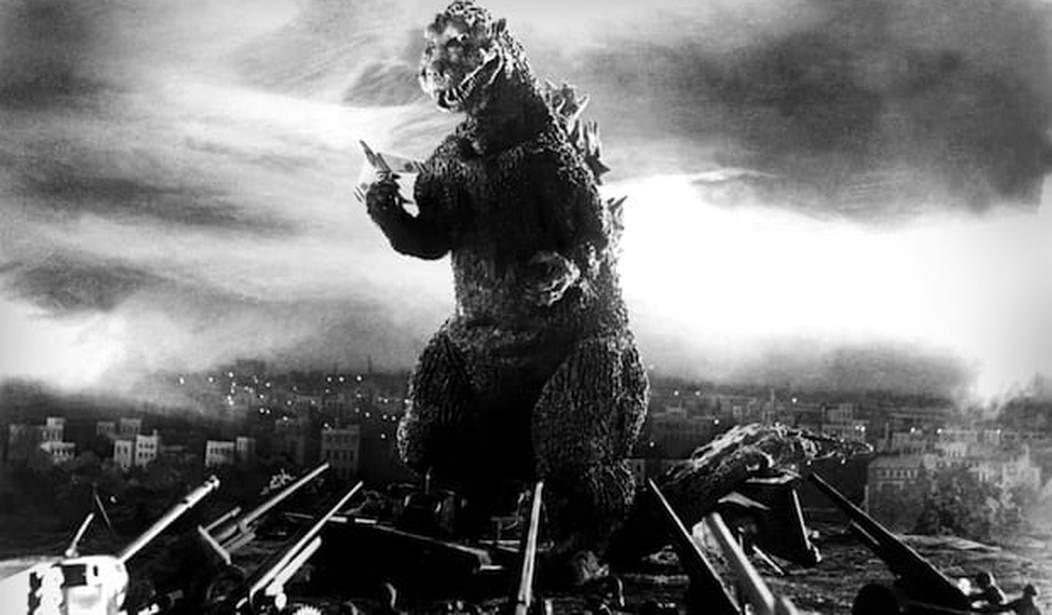I blame 1950s B-movies: sixty years later, it appears that most of what journalists know about radioactivity came from watching Godzilla.
On February 8, Adam Housley of Fox News reported a story with a terrifying headline: “Radiation at Japan’s Fukushima Reactor Is Now at ‘Unimaginable’ Levels.” Let’s just pick up the most exciting paragraphs:
The radiation levels at Japan’s crippled Fukushima nuclear power plant are now at “unimaginable” levels.
[Housley] said the radiation levels — as high as 530 sieverts per hour — are now the highest they’ve been since 2011 when a tsunami hit the coastal reactor.
“To put this in very simple terms. Four sieverts can kill a handful of people,” he explained.
The degree to which this story is misleading is amazing, but to explain it, we need a little bit of a tutorial.
The Touhoku earthquake and tsunami on March 11, 2011, along with all the other damage they caused, knocked out the TEPCO Fukushima Daiichi (“plant #1”) and Daini (“plant #2”) reactors. Basically, the two reactors were hit with a 1000-year earthquake and a 1000-year tsunami, and the plants as built weren’t able to handle it.
Both reactors failed, and after a sequence of unfortunate events, melted down. I wrote quite a lot about it at the time; bearing in mind this was early in the story, my article from then has a lot of useful information.
Let’s dispose of the silliest error first: “Four sieverts can kill a handful of people.”
Here’s what he really means: an exposure to four sieverts total dose will kill about half the people exposed. If you were inside the reactor, after a little over two minutes of exposure the chance you’ll die is 50/50.
Next, let’s look at the terror headline itself, the “unimaginable” level of radiation.
Here is a schematic of a “boiling water reactor” which is what is at the Fukushima plant. The “1.” and “2.” I’ve added; they’ll be important in a minute:

To get a little bit better information than the Fox story, let’s go instead to the Science Alert website for their article on this:
The radiation levels inside Japan’s damaged Fukushima Daiichi nuclear reactor No. 2 have soared in recent weeks, reaching a maximum of 530 sieverts per hour, a number experts have called “unimaginable.”
Now, let’s refer back to the image above. Most commercial nuclear reactors have what’s called the “primary containment” around the reactor: a sealed steel or reinforced concrete shell around the actual reactor. Outside that is the “secondary containment,” another sealed building surrounding the primary containment. The unexpectedly high radiation levels — and 530 Sieverts is way high, no question — were detected inside the containment, the area marked by “1.”
This is important, because everyone in Japan is in the area marked by “2.”, technically called outside the containment. This is a Good Thing. What’s even better is that we now know the radiation exposure in area 2 was only about 15 percent of what was originally thought.
So, the tl;dr here is: “Don’t panic. The high radiation is only inside the reactor.” I will say, though, that I wouldn’t recommend anyone going into the containment vessel.

Chernobyl “elephant’s foot” — slag from the meltdown
At Fukushima Daini, they got a robot close enough to measure the radiation level close to the “elephant’s foot” — the mass of slag that results when the reactor melts down. This was very high — the article mentioned 530 Sieverts, but it’s unclear what they mean, because Sieverts are a measure of biological damage, not radiation dose. Still, it’s way high. (Reading news reports about these things can be very frustrating.)
While we’re here, let’s look at Housley’s other attempt at a factual statement:
“The worry is with 300 tons of radioactive water going into the Pacific every day, what is that doing to the Pacific Ocean?” said Housley.
This, at least, is something we can evaluate.
Radioactivity is measured with two units, the Bequerel and the Curie; the Bequerel is ridiculously small, the Curie ridiculously large. (You can find a long detailed explanation in my article “Understanding Radiation” from the time of the Fukushima accident.) A Bequerel is one decay event per second.
TEPCO and the Japanese government carefully measure the radioactivity in the water being released, and report it regularly. Their February 1 report records only one significant radionuclide in the water: tritium, the third hydrogen isotope. The radioactivity level is between 780 and 820 Bq per liter of water.
What does this mean? Well, the U.S. EPA safety standard for tritium in drinking water sets an upper limit of 740 Bq/liter. Basically, you wouldn’t want to drink it, right there at the outflow into the Pacific, for any extended length of time — although it probably wouldn’t hurt you.
You could swim in it, though.
So what have we learned today?
We learned that inside the reactor containment at Fukushima Daini, site of the post-tsunami reactor accident, it’s very very radioactive. How radioactive? We don’t know, because the dose rate has been reported in inappropriate units — Sieverts are only meaningful if someone is inside the reactor to get dosed.
Then we learned that the Fukushima accident is leaking 300 tons of radioactive water — but until we dig into primary sources, we didn’t learn the radioactive water is very nearly clean enough to be drinking water. So what effect does this have on the ocean, as Housley asks? None.
The third thing we learned — and I think probably the most important thing — is to never trust a journalist writing about anything involving radiation, the metric system, or any arithmetic more challenging than long division.










Join the conversation as a VIP Member